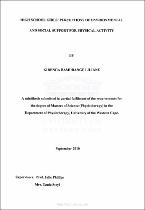| dc.contributor.advisor | Phillips, Julie | |
| dc.contributor.advisor | Steyl, Tania | |
| dc.contributor.author | Liliane, Kirenga Bamurange | |
| dc.date.accessioned | 2023-05-25T12:36:36Z | |
| dc.date.available | 2023-05-25T12:36:36Z | |
| dc.date.issued | 2010 | |
| dc.identifier.uri | http://hdl.handle.net/11394/10048 | |
| dc.description | Magister Scientiae (Physiotherapy) - MSc(Physio) | en_US |
| dc.description.abstract | According to the World Health Organization (WHO), physical inactivity or sedentary life is one of the leading causes of the major non-communicable diseases, which contributes to the global burden of diseases, death and disability. Regular physical activity has significant benefits for health, and everyone should engage in at least 30 minutes of moderate physical activity every day. Girls are reported to be less active than boys. The amount of physical activity declines with the increasing age and this decline is greater in girls than boys. The aim of study was to determine Rwandese high school girls' perceptions regarding environmental and social support for physical activity. A descriptive study using a cross sectional survey was used. Six high schools in Kigali, Rwanda, registered for the academic year 2008-2009, were selected. Three hundred and fifty (350) high school female leamers were selected using a stratified random sampling technique. The participants were selected by class or grade. A self-administered questionnaire, including questions from the Physical Education Program Improvement and Self-study as well as the Modifiable Adolescent Physical Activity Questionnaire was used to collect data. Descriptive and inferential statistics were calculated with the Statistical Package for Social Sciences (SPSS) version 16.0. Chi square and student t-tests were used to determine the association between perceived support and socio demographic characteristics.
Alpha level was set at 0.05. The mean age was 16.06 years (SD=1.4). The majority of leamers in both categories reported not to meet the average of days required for moderate days of physical activity (66%) as well as for vigorous days of physical activity (709%). Almost one third (34%) of the participants were classified as physically inactive while 66%o were as physically active when WHO's guidelines for classification of physical activity was used. The overall study sample responded positively when asked about support for physical activity in the school environment. Furthermore, the overall study sample responded positively to friends' support but negatively when asked about the family support. Significant differences were observed between support from family, social support and moderate physical activity. The findings of the present study highlight the need for the planning and implementation of a physical activity intervention program for high school girls in Rwanda. | en_US |
| dc.language.iso | en | en_US |
| dc.publisher | University of the Western Cape | en_US |
| dc.subject | High school girls | en_US |
| dc.subject | Environmental and social support | en_US |
| dc.subject | Physical activity | en_US |
| dc.subject | Social support | en_US |
| dc.subject | Rwandese high school | en_US |
| dc.title | High school girls' perceptions of environmental and social support for physical activity | en_US |
| dc.rights.holder | University of the Western Cape | en_US |

